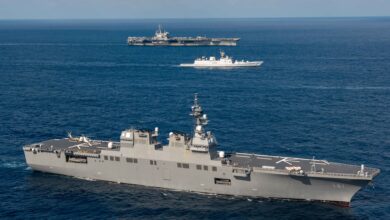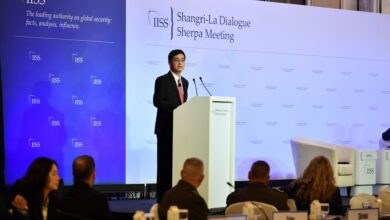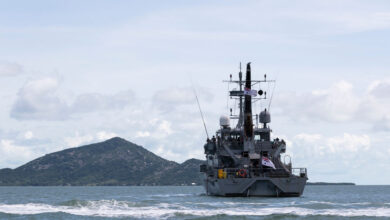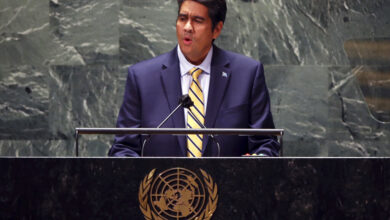Many Sri Lankans don’t trust Chinese motivations for investment in port area

FORUM Staff
Hundreds of Sri Lankans, including Buddhist monks (pictured), protested the opening in January 2017 of a planned investment zone, to be funded by China, and the government’s leasing of a nearby port in Hambantota, Sri Lanka, to China, according to wire reports.
The demonstrators contend that Sri Lankan President Maithripala Sirisena’s administration intends to evict thousands of families from the area to open 6,070 hectares of space for a new industrial zone for the Chinese, Reuters reported.
Police arrested 52 demonstrators, and at least 21 people were injured during the protests, according to Reuters. Police used roadblocks, tear gas and water cannons to control the crowd, many of whom threw stones at government supporters who then responded in kind, according to accounts by Agence France-Presse and The Associated Press (AP).
Sri Lankan Prime Minister Ranil Wickremesinghe, who attended the zone’s inaugural ceremony despite the protests, told reporters the deal with China was needed to relieve the debt the nation assumed for construction of the Hambantota port. He and President Sirisena blamed former President Mahinda Rajapaksa — whose government had strong ties to China — for incurring the debt and for propelling the opposition protests. Both the port and airport are running at a loss, government officials said.
China built the U.S. $1.5 billion port and airport in the southern district of Hambantota, about 240 kilometers southeast of Colombo, the capital, as part of its “string of pearls” strategy, some analysts say, according to AP. The strategy entails creating a network of Chinese bases and relationships across the Indian Ocean and surrounding the coast of India in order to increase China’s power in South Asia.
D.V. Chanaka, a member of Sri Lanka’s parliament and a protest organizer, worries the industrial zone will become a “Chinese colony,” AP reported.
“We are against leasing the lands where people live and do their farming, while there are identified lands for an industrial zone,” Chanaka said. “When you give away such a vast area of land, you can’t stop the area [from] becoming a Chinese colony.”
Sirisena’s government is close to reaching a deal with China Merchants Port Holdings Company Ltd. to develop the China-built port. Under the terms, China would get 80 percent ownership through a 99-year lease in exchange for U.S. $1.12 billion.
China has also promised “if everything goes well” to invest U.S. $5 billion over the next three to five years and create 100,000 jobs, Chinese Ambassador Yi Xianlang said during the opening of the investment zone, which the demonstrators protested, Reuters reported.
The Rev. Magama Mahanama, representing the Monks’ Organization to Protect National Assets, said the monks would issue a decree to the government to stop the leasing. Such decrees have traditionally been honored by Sri Lanka kings, according to AP.
“It’s a way of conveying the message that the monks are not for it,” Mahanama told AP. “Ninety-nine years means at least two generations. When they [the Chinese] take root here, what’s the guarantee that we will have it back? There is a major threat of cultural erosion and demographic change.”
Since Sri Lanka’s 26-year civil war ended in 2009, China has invested millions of dollars into the island nation’s infrastructure.




